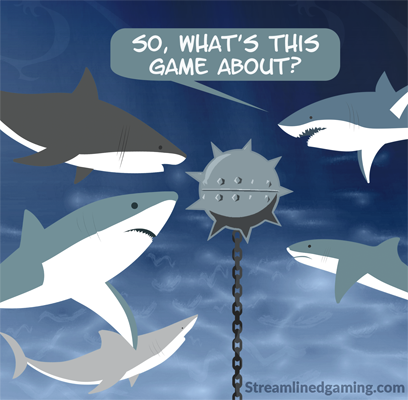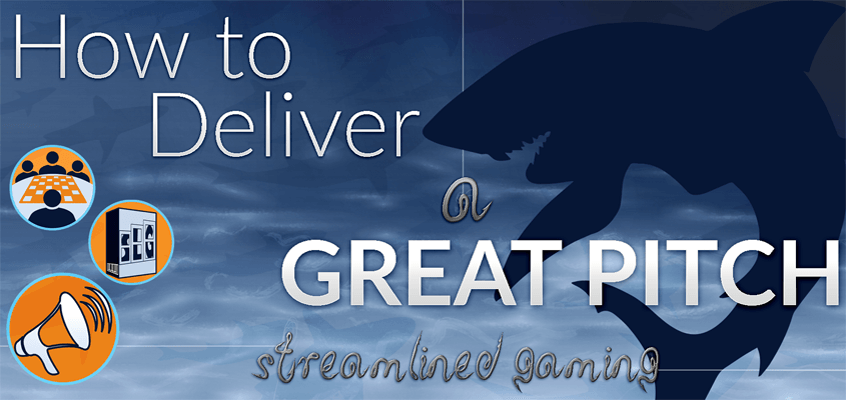“So what’s your game about?” She asked.
I couldn’t move. Couldn’t talk… I was frozen.
“Um, uh, ahh…” I stumbled. This is embarrassing. Why would she ever want to sell my game if I can’t even talk?
I knew everything about my game and had playtested it 276 times (rough estimate) but I couldn’t answer Sarah’s simple question.
Don’t get me wrong. I had assumed that I would be able to answer this question easily had she not asked. But when a potential buyer is in front of you waiting for a reply, it’s much better to have practiced how to deliver a great pitch.
What is a Pitch?
As an aspiring game designer you’ll get asked “What’s your game about?” A LOT. And you need to be ready to answer it.
The answer to this question is your pitch. Specifically, this is your short elevator pitch. The goal of an elevator pitch is to gain interest in your game.
How long should my pitch last?
For a board game, generally 15-30 seconds (3-5 sentences).
That is often enough time to discuss the important information about your game. Remember, you are simply trying to spark the audiences’ attention.
Either the person listening will like it or not.
What information about my game should my pitch contain?
Here is what I have learned through studying hundreds of designers’ pitches. I have heard them from established game designers at conventions (PAX, Gencon) and read them from both first time and established designers online (Facebook groups, Reddit, BoardGameGeek).
6 common elements found in a game pitch:
- Game Name
- Theme
- Game Type
- # of Players
- Target Audience – Who will like playing your game?
- Game Length (Usually this is only mentioned if the game time is shorter than normal. “want to play a quick, 10 minute game?”)
- Wow Factor – What makes your game unique. Even if your wow factor is obvious, you should state it. Publishers love hearing this.
I talked about most of these elements in more depth already. But by simply putting yourself in the shoes of your target audience, think about what elements of your game will be most interesting. Emphasize those elements of your game to the person you are pitching to.
Do they like short games? Then tell them how quick your game is.
Are they looking for a game that can be played by a large group? Tell them how perfect your new party game is for a lot of people.
What is the Goal of Your Pitch?
After you have your pitch assembled, you will want to think about the goal of your pitch. Or “what do you want to happen after you give this pitch to this person?”
Some common goals when pitching your game might include:
- To Find Playtesters – I didn’t realize how important pitching my game to playtesters was. Assuming that my friends and family would just want to play it because I made it was wrong. It’s as simple as “if I make a better pitch, more players will want to play.”
- To Get Published – If you don’t think this is nerve wracking, then you are a robot. Talking to publishers is very hard as an aspiring game designer. Asking (begging) them to spend 1000’s of dollars to create and try to sell your game is even harder. It’s best if you are prepared and have a well thought out pitch days before talking to a publisher. You will thank yourself.
- To Sell your game – So this could mean pitching your game to a Kickstarter audience. Or it could mean convincing someone like Sarah (distributor) to buy a lot of your games at a discount and sell them.
When you pitch to playtesters and publishers, it is usually face to face. This is harder for me than it is if I were to pitch to an online audience because I have time to lay out my thoughts.
Maybe you are different and are awesome at delivering a great pitch in person. But in either case, practice makes perfect so try and pitch to yourself in the mirror or grab a friend willing to listen and give honest feedback.
Who is Your Target Audience?
The audience goes hand in hand with the goal of your pitch.
3 types of people you will have to pitch your game to:
1. Playtesters
A lot of game designers (my younger self included) don’t realize the importance of pitching your games to potential playtesters. This is a big mistake. Learning how to deliver a great pitch is crucial for a couple of reasons.
- It will build up excitement for your game – Other people get excited when you are excited. This is basic human nature. And the same is true when experiencing how to deliver a great pitch.
- It will target the appropriate testers – You don’t want someone that hates deck-building games playtesting your deck-building game. At best they won’t be buying your game and will provide poor feedback. Or at worst, they will discourage you by acting bored and/or telling you your game is bad.
2. Publishers
This is the typical person designers think of when they hear the word “pitch”. You will need answers to the following questions when pitching to a publisher:
- What types of games do they typically publish?
- Who is their target audience? – Does it match your games’ target audience?
- Are you willing to let the publisher alter your games’ theme? – A publisher may enjoy the way your game plays, but want to add their own theme (and art) to match their collection of games. This is more common than you may think but is a topic that you should be prepared to respond to.
3. Customers
Again, if you are selling the game yourself (Kickstarter or your own website), then you will need to know how to pitch to your customers (target audience).
Who do you think will buy your game?
- Families
- Couples
- Kids/Adults
- Trading Card Game (TCG) players
When you are improving how to deliver a great pitch to your customers, keep these people in mind as you write and edit your pitch.
Summary
When I first was learning how to deliver my game pitch, I thought a “1 pitch works for all” would be good.
Unfortunately, that is not the case. For a great pitch, you must customize it based on several items such as your audience and goal.
Don’t be afraid to practice in front of a mirror or with a friend/family member. Think back on those dreaded nights before you were to give a speech in your communications class. It was tough! But remember how much harder it was when you didn’t practice?
Apart from this post, are there lessons you have learned on how to deliver a great pitch for your game? Help your community out by giving your expertise in the comments below.


gate io withdrawal limit
Thanks for the report, Graham!As you pointed out age/health issues plus ongoing concerns with the current COVID situation has been a real dampener on such events, so it is a little unfair to judge people harshly on this. Plus, it my have been too short notice for others, given it is Easter weekend too and they may have already made plans.Maybe next year things will see an upturn in attendance if the situations improves, but thanks for flying the OVFM flag for us! 🙂
binance алдым-ау
Can you be more specific about the content of your article? After reading it, I still have some doubts. Hope you can help me. https://accounts.binance.com/kz/register-person?ref=V3MG69RO
Account binance
Your article helped me a lot, is there any more related content? Thanks! https://www.binance.info/it/join?ref=V2H9AFPY
Compte Binance gratuit
Thank you for your sharing. I am worried that I lack creative ideas. It is your article that makes me full of hope. Thank you. But, I have a question, can you help me? https://accounts.binance.com/fr/register?ref=V2H9AFPY
open binance account
Can you be more specific about the content of your article? After reading it, I still have some doubts. Hope you can help me.
binance referencní kód
Thanks for sharing. I read many of your blog posts, cool, your blog is very good.
www.binance.com注册
Can you be more specific about the content of your article? After reading it, I still have some doubts. Hope you can help me.
binance
I don’t think the title of your article matches the content lol. Just kidding, mainly because I had some doubts after reading the article.